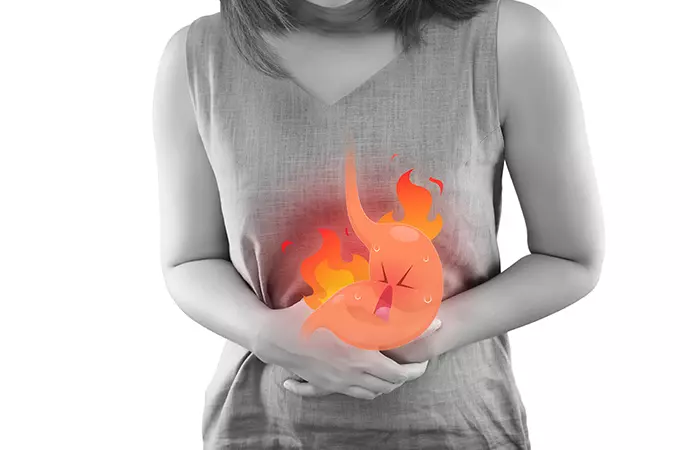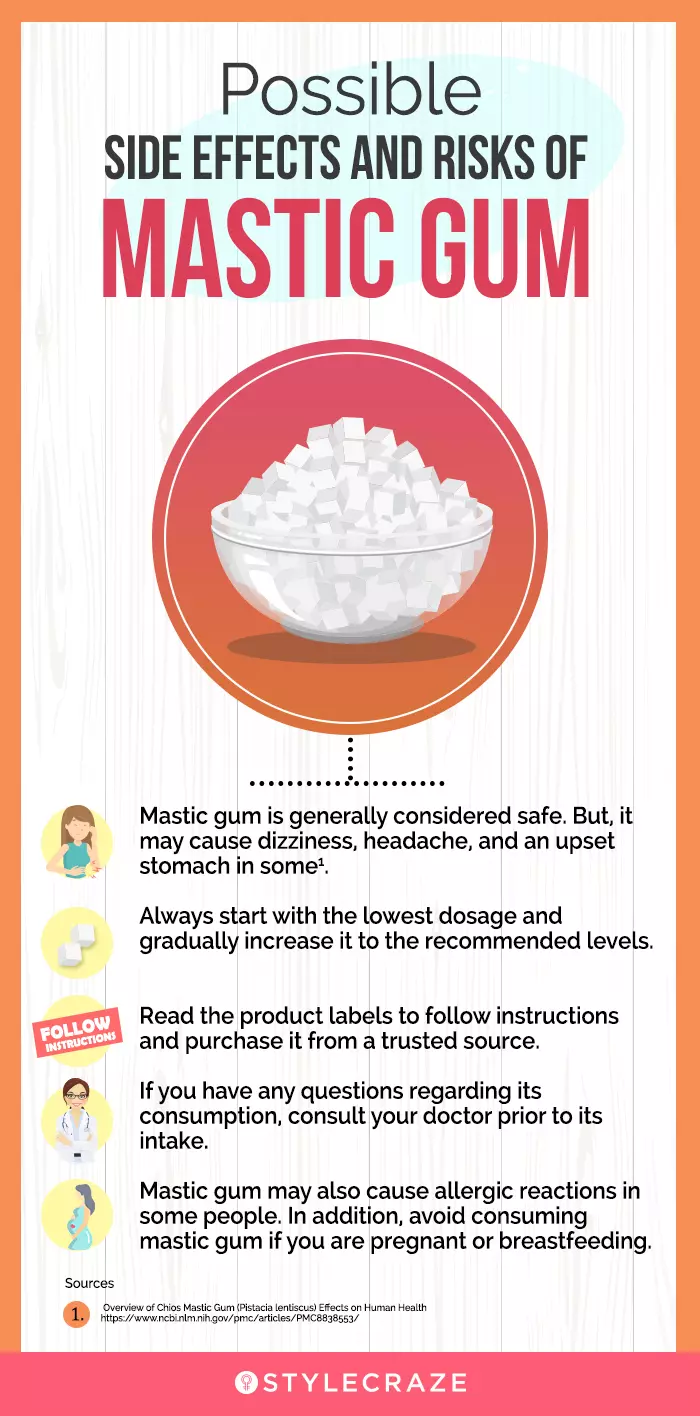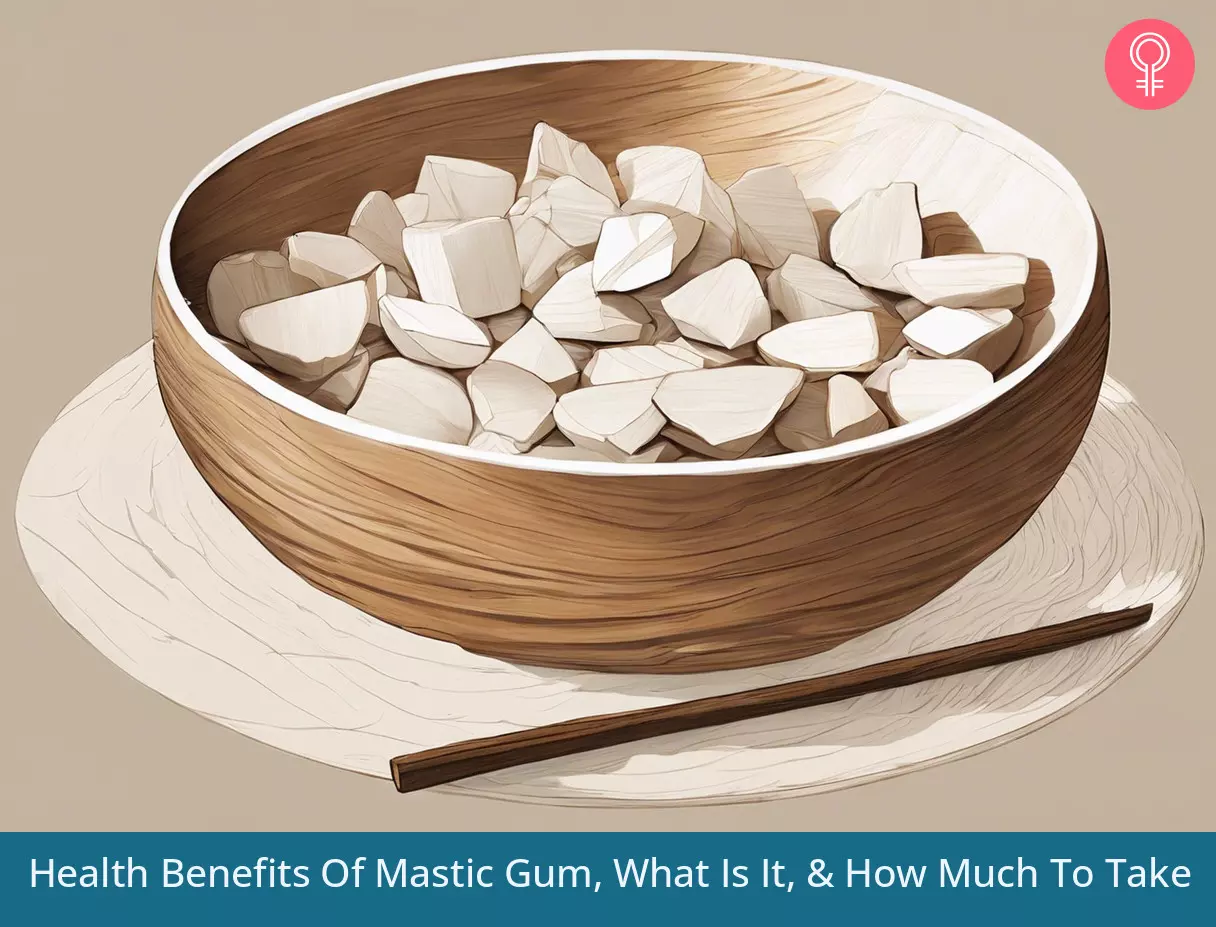It is also a part of Mediterranean cuisine for its therapeutic values, which can help treat several intestinal, stomach, and teeth problems. This article explores the potential health benefits of mastic gum and also explains how much of it you should consume. Take a look.
What Is Mastic Gum?
Mastic gum is a natural resin produced from the trunk and branches of the mastic bush Who Can Consume It? Can be safely consumed in moderation by all. However, it is better avoided by pregnant women. How Often? The exact dosage must be confirmed after consultation with a healthcare professional. Caution Overconsumption may cause stomach problems, headaches, and dizziness.
(Pistacia lentiscus var. Chia). This gum is produced in the form of tears when you cut the bark. Mastic gum drips through these incisions as a clear, gummy liquid that solidifies over time. These translucent-opaque granules of mastic gum are cleaned, segregated, and processed further (1). Traditional medicine has used mastic gum as a remedy for several gastrointestinal disorders. The Greeks believed it could treat gastralgiai A pain inside or outside the muscle walls of the stomach triggered by digestive issues, overeating, stress, or constipation. , peptic ulcers, and dyspepsia. The anti-ulcer activity of this resin is experimentally proven too (2). Mastic gum is rich in various nutrients that may improve your health. Learn more about it in the next section.
Mastic Gum Nutrition
A hundred grams of mastic gum has the following nutrients: It is important to note that there is limited data available regarding the nutritional profile of mastic gum. However, research suggests that mastic seed oil contains 52.4% of monounsaturated fatty acids and 21.18% of polyunsaturated acids, which may reduce the risk of cardiovascular diseases (4),(5). Mastic gum has potential antimicrobial, anti-inflammatory, and antioxidant properties that may help fight infections and improve symptoms of inflammatory conditions (2), (6). The therapeutic properties of mastic gum may benefit your health in many ways. Find out how in the next section.
3 Main Ways Mastic Gum Can Benefit Your Health
1. Can Reduce H.pylori Infection, Ulcers, and Inflammation
Mastic gum possesses antibacterial properties. It is, hence, possibly effective in reducing Helicobacter pylori infection. This progressive pathogenic infection can lead to chronic gastritis and gastric ulcers if left untreated (2). Mastic gum extracts showed about a 30-fold drop in H.pylori colonization. But there’s not enough evidence backing this (2). However, some hypothesize that this property is because of the mono- and sesquiterpenoids (essential oils) and triterpenoids (e.g., masticadienonic acid) the gum contains (1). Also, this resin has no/minimal side effects on long-term consumption. So, the habitual intake of mastic gum might control the colonization of H. pylori in your stomach (1), (2). Ellie, a blogger, shared her experience dealing with a H.pylori infection and how painful it was. She had tried so many methods to cure the infection, but using mastic gum supplements was one of the easiest and most effective ways to treat it. She writes, “It was the last supplement I bought, but should have been the first! Within a few days, I started to feel a difference! This is what I feel killed my H Pylori (i).”
2. Works On Functional Dyspepsia
Dyspepsia is the uncomfortable feeling or pain in the upper-middle part of your stomach. It is usually accompanied by bloating, heartburn, nausea, vomiting, and burning stomach ache. In various studies, hydrogen receptor antagonists and proton-pump inhibitors did not improve dyspepsia. Herbal remedies like Iberogast and artichoke leaf extract showed promising results. Mastic gum is a well-known herbal alternative that can treat this condition (3). Almost 25% of its total weight is a polymer. In an acid environment, this becomes a runny resin, which could have gastric cell-protectant effects in patients. The gum has triterpenoid acids that could have antimicrobial and antioxidant effects on these cells (3). Dyspepsia patients treated with mastic gum showed double the improvement in the placebo group (3). Identifying the active substances of the resin involved in fighting dyspepsia can give more clarity about its dosage and specificity.
3. Can Reduce The Severity Of Inflammatory Bowel Disease (IBD)
Inflammation of the parts of intestines can cause inflammatory bowel disease. This inflammation can be a result of a pathogenic attack, fat accumulation, gastritis, etc. Crohn’s disease and ulcerative colitis are common forms of IBD. Due to its established anti-inflammatory effect, chios mastic gum could make an excellent remedy in this case. It also possesses antibacterial and antioxidant activities that can help address the cause of IBD (9), (10). In several studies, mastic gum treatment reduced the severity of Crohn’s disease. It lowered the levels of pro-inflammatory compounds in the serum, such as IL-6, CRP, and TNF-α(9), (10) . Mastic gum also inhibited other factors responsible for the migration of white blood cells to inflamed sites (10). Seems like mastic gum is a great go-to for all GI and excretory tract issues! Any idea what is/are behind such potent cytoprotective properties? Here is the answer!
What Are The Active Components Of Mastic Gum?
Mastic gum has anti-inflammatory and antioxidant activities because of a power-packed biochemical profile. It has triterpenes of oleanane, euphane, lupine-type. Alpha-tocopheroli A naturally-occurring type of vitamin E and fat-soluble antioxidant that helps break the chain of oxidation reactions. , polyphenols, verbenonei A natural organic compound found in plants and many essential oils and has a pleasant odor. , alpha-terpineoli A terpene alcohol used mainly as an aromatic compound in perfumes, oils, cosmetics, and flavors. , and linalool were also identified in the resin. Triterpenes have been associated with the hypotensive effect of mastic gum. Linalool and similar compounds were responsible for its antibacterial activity (11).
How Much Should You Take?
Ingesting or chewing mastic gum can clear your teeth, tummy, and bowel. About 0.06 mg/ml of this resin could effectively kill H.pylori. Concentrations as low as 125 μg/ml and 500 μg/ml inhibited 50% and 90% of H. pylori strains (12). However, further information is required to help decide the right dosage of mastic gum. Until then, you may contact your physician or nutritionist to know more about this resin. Is mastic gum good for kidneys? Yes. Mastic gum contains antioxidants that aid kidney function. Is mastic gum a prebiotic? No, mastic gum is not prebiotic. But, it can improve gastrointestinal issues. Does mastic gum lower blood pressure? Mastic gum can reduce blood pressure in patients with arterial hypertension due to its antioxidant and anti-inflammatory properties (13). Is mastic gum good for the pancreas? Yes, mastic gum can improve pancreatic health. Mastic gum paired with gemcitabine may be an effective therapy for pancreatic cancer (14).
Illustration: Health Benefits Of Mastic Gum What Is It & How Much To Take
Explore the remarkable probiotic benefits of mastic gum in this informative video below. Check it out now and discover its potential to enhance gut health and overall well-being.











